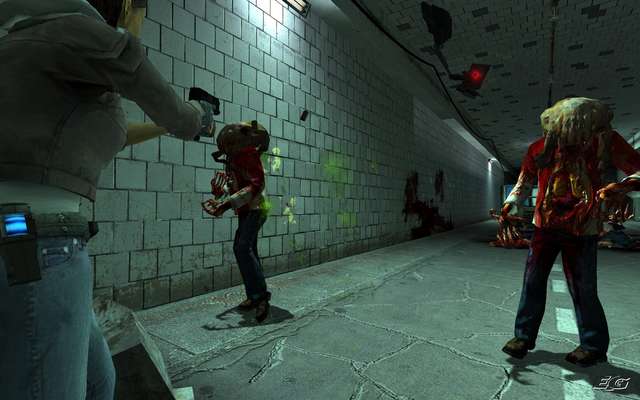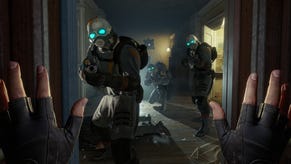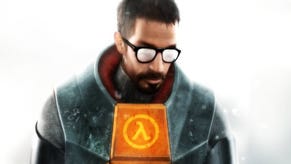Half-Life 2: Episode One
Eurogamer 4 Valve 2.
Zombine harvester
Take the combat, for example. Valve's decision to throw contrasting types of enemies at you at once is a fantastic and well-realised one that makes the firefights far more dynamic, unpredictable and therefore more interesting than ever. Rather than have to do battle with a posse of lurching zombie headcrabs on their own, suddenly you might find yourself having to fend off the much faster, more vicious 'Zombine' (zombie combines...) in addition to leaping headcrabs, fast-moving skeleton zombies and even Combine forces, all at once. Sometimes you'll actually intrude on massed battles in progress between the Combine forces and, say, Antlions or gangs of grenade-wielding Zombines. Usually, you'll smugly hang back and let them try take each other out before you get involved, only to find reinforcements pouring onto the scene to wipe the smile off your face.
With no ability to command Antlions yourself this time, you'll have to find neat physics-based solutions to conquer their arrival, while the suicidal tendencies of the grenade-wielding Zombines calls for cunning use of the gravity gun to literally whip explosives out of their hands before they blow you and everyone in range to pieces. Later, the Zombines become even more deadly as they stagger towards you with several poisonous headcrabs stacked on top of their toppling bodies. As they threaten to attach themselves to your face you'll wonder whether you can take them down quickly enough - but the chances are you'll just flee the scene in terror. Such panic-inducing moments aren't exactly rare.
But Episode One isn't always full of magic moments. The opening chapter 'Undue Alarm', for example, sees Gordon armed only with the Gravity Gun, meaning the whole level relies solely on the rather repetitive process of grabbing and lobbing objects (and/or the Combine onslaught) to make progress. Although it's an atmospheric introduction and pleasant fun reactivating bridges and knackered machinery, you're entirely reliant on Alyx to do the shooting, so you'll be glad when the 'Lowlife' chapter kicks in and you can get back to basics a little. Undue Alarm is a bit like when Half-Life 2 ended, but in reverse, and without the intensity of its unbridled chaos. That isn't necessarily a good thing.
What's next?

Valve's smart enough to keep switching styles, though, and consistently manages to continue its knack of making each chapter interesting and varied enough for you to always want to know what's around the next corner; it's the gaming equivalent of an addictive page-turner. Part of the reason is the constant variety and the fact that there aren't any stupid difficulty spikes thrown in to artificially pad things out. As a result, you'll happily plough through all five hours in one sitting and never once get bored or exasperated. Seriously, how many games can you say that about?
Even once you've run through the entire game, few Valve fans will want to miss out on the game's wonderful commentary system. Gamers can wander around the game world and stop and listen to all manner of insightful information voiced by Gabe and the gang themselves by activating the rotating speech bubbles placed at strategic intervals. So well implemented is the idea, it's perhaps only a matter of time before other major developers follow suit.
Once again, as a technical achievement, Episode One is absolutely stunning, and there's no denying that the effects debuted in Lost Coast are more than welcome in the context of a full game. Complete with sumptuous High Dynamic Range (HDR) lighting effects (where your eyes take time to adjust to sudden changes in light), motion blur, and a more believable animation system, Episode One looks even more impressive than the already-stunning Half-Life 2 did. Most of the improvements are incredibly subtle, though, and whether you'll get to enjoy them will often depend on your PC's capabilities.
Predictably, the game's star attraction, Alyx, reaps the full benefit of all the extra effort (whereas vanilla NPCs clearly do not) and looks even more facially realistic this time around. With more varied dynamic natural motion seemingly the norm, you may initially miss the way light from monitors glows on her face, or the range of subtle facial expressions or the enhanced quality of her lip-synching and array of context-dependent actions, but close inspection is recommended. And ok, so it's old news now, but it's heartening to finally come across a game that uses HDR in a meaningful sense. Take Episode One's epic gunship battle in the confines of a rapidly disintegrating rooftop attic, for example. When you climb up the stairs of the rickety structure, you'll look up to see white shafts of bright light pouring through the gaps in the busted up roof. Once your eyes have adjusted to the light you'll see (and hear) the gunship continuing to scour the area, looking for a chance to put an end to your escape plans. As the pilot becomes aware of your prescence, a hail of hot lead rains down onto the rickety structure, splintering beams and ripping roof tiles off to expose the sky and flood more light onto the scene. As far as showing off the technical capabilities of the engine it's a hugely impressive demonstration of the Source engine that not only looks and feels like a scene ripped straight from a blockbuster movie, but has genuine gameplay implications as your cover gets exposed and even the floor supporting you gets ripped away in a flurry of bullets. It's not just about avoiding being shot, but trying to keep your footing, too. In short, it's one of many such highlights in Episode One and a distilation of the sort of intense scenario that Valve excels at.
Sounding off

During such intense action sequences, you're constantly reminded of the difference that top quality audio can make to a videogame. Alongside the deafening bursts of gunfire and Combine chatter, the underlying swell of the atmospheric soundtrack stomps its way into your consciousness. As ever, the music punctuates only the most alarming parts of the game and is well up to the superb standard set in previous titles. Somehow it manages to be not only entirely listenable in its own right, but uncannily appropriate for the settings. One day Valve might sell the soundtrack (hint hint). But just as important is the peerless standard of voice acting which, once again, shows many of Valve's stumbling competitors what they should be aiming for. Kudos, too, goes to Valve for keeping faith with the same 'classic' sound effects it as used since the first Half-Life stole our hearts. Call us sad, but we'll never tire of the sounds of erupting barnacles, the spark of electricity or a recharging hazard suit. When we eventually die, we fully expect that flatlining noise to be the last thing we ever hear.
But as much as we all love to cling onto classic elements, though, it's fair to assume that some of the less partisan fans will feel a pang of disappointment that Valve hasn't done more to shake up the Half-Life status quo a bit - but maybe that would be missing the point of what Episode One was trying to achieve. In truth, the main focus for this release wasn't to be a sequel and change the recipe, but to deliver more of what we loved about HL2 while advancing the storyline. As an exercise in revealing how Gordon, Alyx and company manage to cope with the disintegrating Citadel and how they escape the hellish confines of City 17, it does the job just fine. (To explain or discuss the story in any more detail would ruin a large part of the point of playing it in the first place, so we'll resist that particular temptation). So long as that's clear, we can resolutely assure the legion of Half-Life 2 fans that you won't want to miss out on what is a fine adventure that's well up to Valve's impeccable standards.
Perhaps we'll only really be able to fully judge the Half-Life 2 Episodes in context once we've played all three, but even at this early stage it's abundently clear that there's more gameplay variety and design inspiration in the first five hours than most full-length games at triple the price. Throw in the fantastic 'director commentaries' on top and you've got even more reason to invest.
Just like the original Half-Life 2: Episode One keeps the player entertained almost the entire time through perfect pacing, a rich atmosphere and incredible production values. By being inventive, surprising and getting the basics absolutely right, Half-Life 2: Episode One is a wonderful advert for the excitement that true episodic content can generate when approached the right way. The sooner more developers go down this road, the better.








